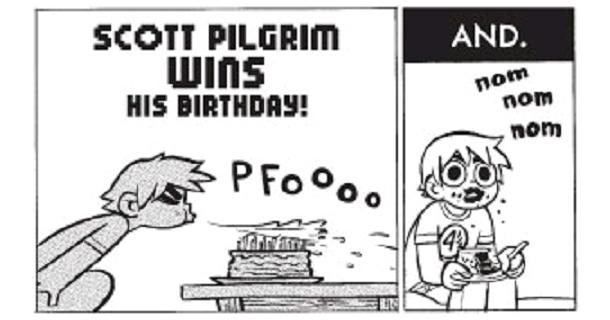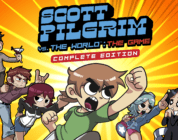“Scott, if your life had a face, I’d punch it.”
I don’t know how Bryan Lee O’Malley coordinated it, but he somehow did a brilliant job at making 2010 contain “The Summer of Scott Pilgrim.” His comic series, which has been in production for the past six or seven years, is attaining a culmination that few original intellectual properties strive for.
The sixth and final book in his series was recently published earlier in July, with a video game spin-off and feature film to follow in the first half of this month, both of which look like well-produced adaptations that fit their respective forms of media. It’s a major one-two-three K.O. and is sure to round up a healthy audience of followers no matter which of the three mediums they prefer. No doubt the movie and video game will take different approaches to the original concept O’Malley set in place with his comics, as is expected, but it’s safe to assume that the comic series will contain the most in-depth story of the three divisions of Scott Pilgrim media.
For those of you who have been blissfully unaware of this franchise as it has swept the nerd culture ina frenzy over the past few months, Scott Pilgrim is a coming-of-age story about a 23 year-old Canadian dork who finds himself running into a mysterious girl in his dreams, only to come to realize that this strange young lady exists in reality in form of an American girl delivering packages for Amazon.ca. Her name is Ramona Flowers. This literal girl of Scott’s dreams becomes an obsession quite quickly, and he finds that he must pursue her love. What he doesn’t realize is that in order to earn the right to date the girl proper, he must first defeat her seven evil exes in combat.
Already the concept is a twist on the strikingly familiar setup of many video games: in order to save the princess, one must collect the seven mystical doodad whatzits, etc. The Scott Pilgrim books deftly meld video game and nerd culture into the story. All manner of references to many games from the 80?s and early 90?s are made, with some moments blatantly alluding to games like Sonic the Hedgehog, Legend of Zelda, River City Ransom, and Ninja Gaiden. When Scott defeats his foes they are obliterated into pocket change or an Extra Life. There are all kinds of HUD jokes, ranging from gaining EXP for getting a job to draining a Pee Meter when going to the bathroom. The gaming humor is sporadic and inconsistent, which means it never gets old or repetitive.
What’s more is that this series is clearly written by a true-blue gamer. Outside of the crazy Street Fighter combos Scott will whip out on enemies, even the dialogue will make references to various elements of gaming in a natural but entirely dorky fashion. It never once, throughout the whole series, feels unnatural or forced or contrived in its referential humor. It’s organic and form fitting, from comparing dreams to the world of Subcon in Super Mario Bros. 2 to reciting the bass line chords to the battle music in Final Fantasy 2.
But the crazy, zany antics of Scott Pilgrim’s ‘Precious Little Life,’ which the movie looks to put front and center, are not all there is to this story. It is surprisingly character driven for how quirky and fast-paced its storytelling is. Some characters are there for a laugh, but many are there to butt heads with each other or to bring out different aspects of one another’s personality. O’Malley’s writing is at once touching and even thought-provoking one moment but sharp, random, and unexpectedly witty the next. It feels like you are being taken on a river rapids ride with its brisk pace of narrative, but every now and again slows things down to give you a moment to take in the deeper emotions at play.
From an art standpoint, these books have a flavor all their own. This isn’t manga and it isn’t Marvel/DC. O’Malley has his own unique style that is practically recognizable at first glance. Ironically enough, his style is so consistent that, given the series is 98% in black and white, it occasionally became slightly difficult to tell which character was which. This is a bit of an issue for a graphic novel, but it’s fortunately never so hard to distinguish characters that it negatively impacts the story, as dialogue usually helps establish who is who just in case you ever get confused. Environments are simplistic in design but detailed enough to portray subtle elements of atmosphere to observant eyes. Facial expressions are superb, always capturing the character’s tone and mood so you know not just what they say but how they say it. A number of unique filters and shading techniques add some pop and atmosphere to various sequences as necessary, making scenes visually stand out in a way that makes sense.
On top of all of this, O’Malley incorporates occasional moments of brilliance into his comic design, taking advantage of the medium and formatting various scenes in a way that portrays a sound or a motion through still images extremely well. One example is a scene where Scott is talking with a friend who has a piece of kitchen equipment running. His word bubble clearly has print written inside it, but a large ‘whirring’ sound effect covers the whole word bubble up, disabling you from actually understanding what is being said. Another small moment I recall involves Scott chopping a vegetable, with the words ‘chop chop chop’ squiggly and crooked and unorganized. His co-worker grabs the knife and shows him the right way to do it, his smaller ‘chops’ uniform in size and font and stacked neatly above one another. There are so many small but ingenious moments like this that remind me of how the graphic novel medium is only dead in creativity when we let it be.

Scott Pilgrim Wins His Birthday!
Without spoiling the story, the characters are worth discussing. Each one kind of brings their own element to the table, but many of the characters end up feeling like they’re there just for the sake of being there. Most characters have no development, or character arc, they’re just there. Some characters I even see being easily cut from the film and/or game altogether because they really served no substantial purpose. Scott himself is actually a pretty oddball protagonist, for better or worse. He randomly bounces back and forth between being a total nutcase goofball who can’t remember anything to a determined, courageous romantic. Compared to some of the other characters, Scott himself actually comes across as kind of an immature, insensitive jerk, even in the beginning of the final book. He’s ultimately likeable but, in my tastes, in a kind of haphazard way. I found myself pissed off at him just as often as I was proud of him. As a matter of fact, with how many girls find him attractive and/or have feelings for him, I eventually found it somewhat contrived. I can’t really see what there is to him that would make so many female characters of different personality types give him the light of day, save Ramona and one or two others. Perhaps the gratuitous Scott-flirting is intentional, referring to the Japanese culture fantasy fulfillment of multiple girls with multiple personality types all PINING after the same boy (see what I did there, Pilgrim fans?) I honestly have mixed feelings about Scott Pilgrim as a protagonist. He’s likeable but in the same way I like my idiot little brother, not the hero of a story. In either case, it does make for a less-traditional, unpredictable route, and I admit that it’s probably for the best to have a plot revolving around a character who does often make bad decisions and must then deal with them.
Ramona, on the other hand, is very grounded and down-to-earth despite being a girl who carries a massive battle hammer in his purse and travels through subspace on roller skates. She grows a bit as a character by the end of the story, but she’s at least consistent. Kimberly Pine, also, is a layered character whom you think you understand at first but come to feel differently about as you learn more about her. All in all, the cast is generally likable with a few you really and truly care for by the end with some flatter characters to round out the package for anticipated bouts of humor.
All in all, the Scott Pilgrim books combine unpredictable comedy, nerd culture references, problem-riddled romances between characters with troubles histories, character development, and quirky manipulations of the graphic novel medium to form a series that is entirely fresh and unique. It’s no wonder it’s getting the multimedia treatment, because it’s highly creative in the way it parodies pre-established archetypes while spicing things up with its own personal flair and flavor. What’s more is that O’Malley approaches his off-kilter storytelling with a sense of realism in how his characters conduct their lives. They make stupid decisions, they get drunk, they tell lame jokes, they struggle with insecurities and face everyday circumstances of social awkwardness…I was reading a story about people in their mid-twenties (my current age demographic) and I genuinely felt like that was exactly what these characters acted like. Just, you know, with more kung-fu and subspace highways. Scott Pilgrim as a graphic novel series sometimes feels a little rushed in its narration, with some scenes ending rather abruptly. Especially with some of the ending sections, I would’ve liked to see just a teensy bit more resolution for some of its characters; however, it has a driving energy that never lets up, laugh out loud moments in spades, and a unique art design that takes advantage of print-based publication. It references a specific section of pop culture in fluid, natural ways that are 100% nerdy but 100% sensible. It feels like an ode to all of us who were raised on the 8-bit and 16-bit gaming consoles and are just now finding our lots in life, learning that real-life adults all have their own baggage, all make terrible decisions, and we have to learn to be OK with that if we’re ever going to get along.
[You can learn more about the Scott Pilgrim franchise and where the books can be purchased here at the official website.]
Stay tuned in the coming weeks, as I’ll be reviewing the movie and video game adaptations!


